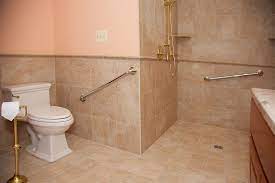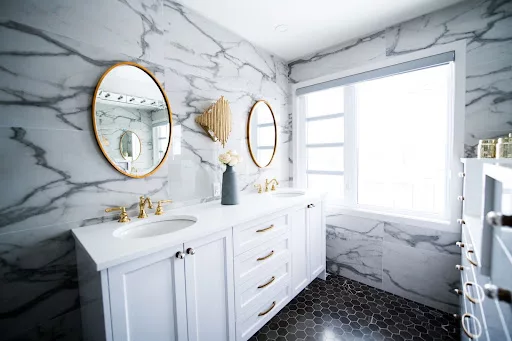Accessible Bathrooms for Seniors
Bathrooms can be a challenging space for the elderly and disabled, as they often require extra support and assistance to perform basic tasks such as bathing, grooming, and using the toilet. Fortunately, there are many Bathroom aids for seniors that can be incorporated into bathroom design to make it easier and safer for these individuals to use that you can install to make your bathroom for the elderly more accessible.
Grab bars
One of the most important safety features in a mobility bathroom designed for the elderly and disabled is grab bars. These bars can be installed in strategic locations, such as near the toilet and in the shower or bathtub, to provide extra stability and support for those who have difficulty standing or maintaining balance. Grab bars should be securely anchored to the wall and be made of a material that is easy to grip, such as stainless steel or plastic.

Non-slip flooring
Non-slip flooring is another important safety feature to consider when designing a bathroom for the elderly and disabled. Slippery surfaces, such as tiles or linoleum, can be a hazard for those who have difficulty standing or maintaining balance and are amongst the most crucial Bathroom aids for seniors. Non-slip flooring, such as textured tiles or rubber mats, can provide extra traction and reduce the risk of falls. It is especially important to have non-slip flooring in the shower or bathtub, as these areas can become especially slippery when wet.
Walk-in Showers
Walk-in showers are another great option for those. These showers have no threshold or a very low threshold, making it easier for individuals to access them without having to step over a high barrier. Walk-in showers can be fitted with a bench or a built-in seat to allow those with mobility issues to sit down while showering. Hand-held shower heads can also be helpful for those with mobility issues, as they can be used to wash the hair.
There are a few different types of walk-in showers available to help the elderly and disabled, and the features they have:
- Wheelchair-accessible showers: `Are amongst the costlier Bathroom aids for seniors. These showers are designed to be used by individuals in a wheelchair and have a wide, flat entrance with no threshold. They often have a built-in seat or bench and can be equipped with hand-held shower heads, grab bars, and other safety features.
- Barrier-free showers: Barrier-free showers have a very low threshold or no threshold at all, making it easy for individuals to walk or roll into the shower. These showers often have a built-in seat or bench and can be equipped with hand-held shower heads, grab bars, and other safety features.
- Roll-in showers: Roll-in showers are similar to wheelchair-accessible showers but are designed to be used by individuals who are able to stand but may have difficulty stepping over a threshold. They have a wide, flat entrance and can be equipped with hand-held shower heads, grab bars, and other safety features.
Some common Bathroom aids for seniors that can be found in walk-in showers designed for the elderly and disabled include:
- Hand-held shower heads: These shower heads can be used to wash the hair and body without having to stand for long periods of time.
- Grab bars: Grab bars provide extra stability and support for those who have difficulty standing or maintaining balance.
- Built-in seats or benches: These features allow individuals to sit down while showering and can provide a convenient place to store toiletries.
- Non-slip flooring: Non-slip flooring can provide extra traction and reduce the risk of falls.
- Lever-style faucets
To conclude, designing a bathroom with the elderly and disabled in mind is important to ensure safety and have Bathroom aids for seniors. Key features to consider include grab bars, non-slip flooring, walk-in showers, hand-held shower heads, raised toilet seats, safety rails, lever-style faucets, good lighting, accessible storage, and an emergency call button. By taking these factors into account, it is possible to create a mobility bathroom that is safe and functional for those with mobility issues.













